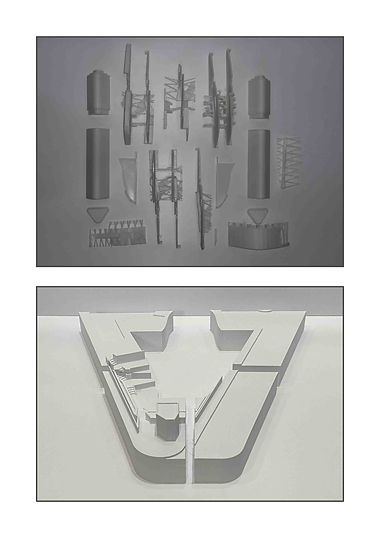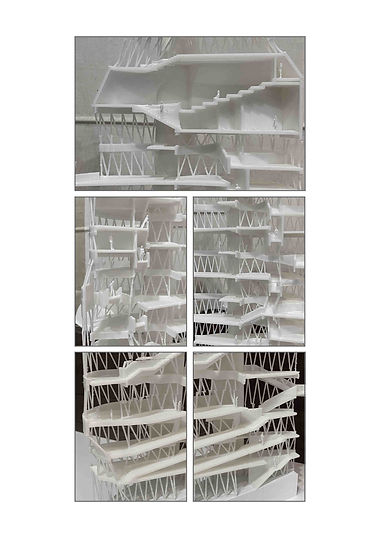
THE TRI-LABYRINTH RETAIL
DESIGN V | TOWER OF POSSIBILITIES | 2021 - 2022
Traditionally, in larger retail space, there are unique and subjective elements that contribute to the overall shopping experiences. These qualities greatly influence the customers' climactic experience and enjoyment that are inherent to the retail process.
In a similar vein, the project aims to explore the concept of an experiential retail within a compact vertical space. Additionally, it delves into the strategy of co-creation, which seeks to complement various cultures by involving the diverse surrounding districts. The objective is to creation a unique and distrinct cultural experience through this collaborative approach based on its surrounding site condition.
Serena Love - Architecture as Material Culture
Building Form and Materiality in the Pre-Pottery Neolithic of Anatolia and Levant:
Journal of Anthropological Archaeology, 2013
Love believes that the choice of building materials and their use in architecture can be considered codes of social practice and even ideology. As a form of material culture, architecture becomes a metaphor for human engagement and symbolic communication.
K. Michael Hays
Critical Architecture - Between Culture and Form, 1984
Hays believed that ‘Mies was able to see his constructions as the place in which the motivated, the planned and the rational are brought together with the contingent, the unpredictable, and the inexplicable’. Mies succeeds in directing the architectural meaning to the outside-to what might be called cultural space -there is the insistence that architecture does not honestly represent the technical, social or economic conditions that produced it’
‘…it should be possible to recognise both the means by which architecture maintains its distance from all that is outside architecture and the conditions that permit the existence of that distance. Hays refers to ‘critical architecture (as one which) exists between the representation of pre-existing cultural values and the wholly detached autonomy of an abstract formal system.’
Today we experience the shift from human-constructed environments set in nature towards machine assembled artificial environments supported by technology. Can we resist the dominance of technocratic cultures in determining our built environment and explore the area between art, craft and technology in architecture?
We are given new opportunities to seek new forms of operation and break away from canonical forms in our consumerist and creative pursuits today e.g. the arts school, the museum, the library, the shopping street and super mall. Our social conditions change in ways which permit us to rethink the notion of the architectural program and its role in defining material culture


URBAN MORPHOLOGY | GRAIN CONDITION
JUNCTION OF SELEGIE ROAD
The site sits along the fridge of four unique districts that reflect a dynamic culture based on its unique characteristics. They are Dhoby Ghaut, Bencoolen, Little India, and Museum, each with its own unique identity and cultural developed based on its prehistoric traditiona and planning methods. For instance, little india is known for its Ayuverdic and Sikh Devotees, while Bencoolen is known for its street food, private art institution and buddhist tradition. What is more critical is that the site is located along the fringe that frame all four different cultures, each having a different clusters or secret threshold that frames within its own characteristic, each unique culture hardly intertwine and rarely speaks for the other culture. The individual cultures of these different practices may prove to be an asset to the landscape around Selegie.

URBAN STRAEGY
MATERIAL | CULTURAL
To enhance cultural diversity, highstreet Fashion and Cultural Heritage could collaborate in the event of co-creating. Research suggests that adopting a brand cultural approch could help assist by providing fresh insights into how brand actors can collectively shape, disseminate, and redefine the existing meanings associated with brands and cultures. For example, the colloboration between high street fashion brand 'Prada' and the 'Chinese Wet-Market' at Shanghai has demonstrated how varies entities has the potential to co-exist in promoting Chinese culture. Similarly, adopting a consumer perspective offers valuable insights into how consumers themselves contribute to the co-creation of brand meaning in the context of cultural heritage.

MASSING ITERATION I
RETHINKING FASHION & RETAIL INDUSTRY
LOWER LEVEL - RETAIL SPACE
UPPER LEVEL - STORAGE SPACE
The fashion retail industry is a highly competitive market, this resulted to the constant change of adopting strategies focused on adjusting the products characteristics and to closely satisfy customers requirements and preferences. Hence, in the fashion industrial of retail, the trend cycle of a products is rather short, where the definition of inventory and purchasing strategies can be supported by the large amounts of historical data that are collected and stored within the company’s databases.
Evolving trends from technologies and machine learning, the future of building and construction may have an impact in a global capitalized society. Could the future of infrastructure be embedded with an A.I. Chips [Brain] in response to the future of fashion trend?


MASSING ITERATION II
RETHINKING TRADITIONAL FASHION
ADDITION & SUBTRACTION OF FLOOR SLAB
LOWER LEVEL - RETAIL ADVERTISMENT
UPPER LEVEL - BACKSTAGE PREPARATION
Traditional fashion industry takes time to adjust for a change in trend. Trends are dynamic and ever-changing forces that adjust according to the rhythm of style and aesthetics which is based on the needs and wants of society. Inevitably, time becomes an asset in the context of a global capitalist nation, especially with the advancement of digitalization and machine learning. Likewise, should the fashion industry require a change in comparison to traditional approaches?
The inconvenience of the fashion industry requires time and large carbon footprint. For instance, whenever the ‘design team’ and ‘marketing team’ proposes a new outfit / product, the ‘design team’ requires coordination with the ‘manufacturing team’ in terms of sourcing the right materials / fabric. When the goods are ready and manufactured, it will then be dispatch to individual ‘retail store’.




STUDY MODEL I
EXPERIENTIAL JOURNEY | SMOOTH VERTICAL TRANSITION
The model adopts the functionality of a scissor staircase by relooking shopping experience especially within a tight vertical space. Interestingly, the two different route of the staircase never meet, unless a bridge is provided to form a connection. Similarly, the project could investigate the idea of ‘ascending’ [as exploring retail] and descending [backtrack to investigate further on interesting retail product]. For instance, the subconscious mind of the buyer is determined to search for a particular fashion trend. Likewise, the idea of ‘ascending’ could be perceived as window shopping, while the idea of ‘descending’ depicts the notion of investigation (which caught the users’ attention while ascending) based on the process of ascending.

MASSING ITERATION III
PROGRAM STRATEGIES
SUNKEN CAFE / BAR WITH LIVE BAND | BASEMENT
OPEN PLAZA / FLEXIBLE AMPHITHEATRE | 1ST - 2ND
DISPLAY STOREFRONT / RETAIL GALLERY | 3RD - 5TH
TRI-COLLABORATIVE RETAIL | 6TH - 7TH
DIGITAL CULTURAL MUSEUM | 8TH - 10TH
CULTURAL RESTAURANT | 11TH
CULTURAL THEATRE | 13TH - 14TH


STUDY MODEL II
INTERCONNECTIVITY | A RHYTHM OF LABYRINTH
Adam Brandenburger & Barry Nalebuff
The Rules of Co-opetition, 1997
Coopetition encourages companies to simultaneously cooperate and compete to achieve mutual benefits. Where traditional notions of competition are likely to overlook the potential for cooperation and collaboration. On hindsight, coopetition encourages competitor to achieve a common goal rather than gain traction.

MASSING ITERATION IV
PIXELATION
ADDITION & SUBSTRACTION OF PROGRAM


PROGRAMMING
PLAN | EXPLODED AXO

SECTIONAL PERSPECTIVE ON PROGRAM


FORM STUDY MODEL I
SCALE 1:100


FORM STUDY MODEL 2
SCALE 1:250


FORM STUDY MODEL 3
SCALE 1:100

ELEVATIONAL DRAWING
DETAILED FORM STUDY

EXPLODED AXO
SPACTIAL PROGRAMMING LOGIC





DETAILED MODEL
FORM TESTING | SPATIAL PROGRAMMING LOGIC

EXPLODED AXONOMETRIC
PROGRAMMING LOGIC

STRUCTURAL AXONOMETRIC
TECTONIC: FACADE SKIN
AS STRUCTURAL COMPONENT

BIOCLIMATIC STRATEGY
SUN SHADING: DEPTH TO HEIGHT RATIO

GROUND FLOOR
URBAN ACTIVITIES

LOWER & UPPER FLOOR
LOWER - BASEMENT CONNECTIVITY
UPPER - CULTURAL THEATRE

INTRODUCTION | DISPLAY GALLERY
4TH FLOOR - COLLABORATIVE EXHIBITION
5TH FLOOR - INFORMAL SEMINAR STAGE

BRAND CULTURE RETAIL | CO-CREATE TYPE I
8TH & 19TH FLOOR - BRAND SHOPPING

REDEFINING ARTISTIC CULTURE | CO-CREATE TYPE II
11TH FLOOR - COLLABORATIVE STUDIO
12TH FLOOR - CO-CREATE DESIGN STUDIO

CULTURAL CUISINE | CO-CREATE TYPE III
13TH FLOOR - PARTICIPATORY COOKING
14TH FLOOR - BACKSTAGE/CO-WORKING

SECTIONAL PERSPECTIVE





FINAL PHYSICAL MODEL

FINAL PRESENTATION BOARD
